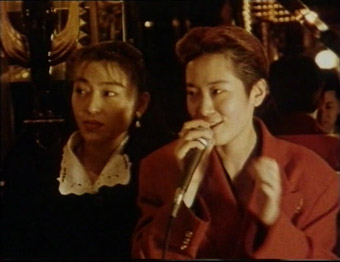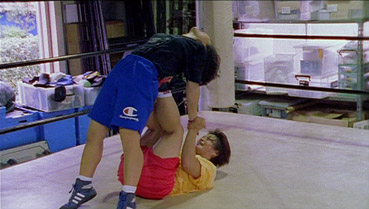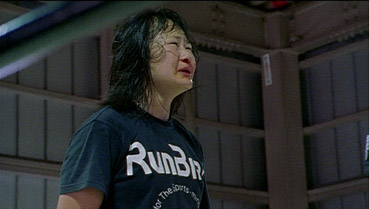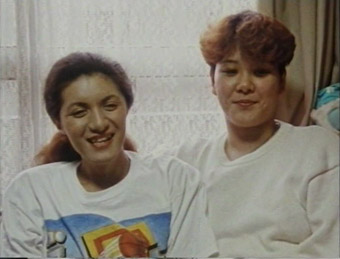|
As something of a Japanophile, I tend to be drawn to any documentary or news items about the country and its people, but too often find that they fall into one of a small number of fixed categories, three of the most common being the country's fascination with modern technology, its seemingly unique marriage of the progressive and the traditional, and aspects of its society that we as foreigners regard as quirky or strange. Now I'd like to state up front that there is nothing wrong with any of these subject headings, but too often there's an underlying suggestion of cultural eccentricity and a sense that we're being encouraged to see these ways as peculiar for no other reason than they're different to ours. The Japanese fascination with modern technology, for example, is no different to our own, it's just that they tend to be at least a couple of years ahead. On one trip to Japan a few years ago, for example, I was surprised at the extraordinary high usage of mobile phones in comparison to the UK, and they weren't just being used for phone calls, but to access the internet and send emails. A couple of years later and we're doing the very same. The comfortable co-existence of the modern and the traditional, meanwhile, is a particularly attractive element of Japanese society, but you'll find a similar mix of old and new in most Far Eastern and even Middle Eastern countries, and in just about every region where religion is still a key aspect of daily life. As for the unusual aspects of a society, well that's in no way unique to Japan and is surely the very reason we visit countries other than our own, to see and experience what we cannot in our own culture. And yet a disproportionate number of recent televisual reports on Japanese technology have been focussed on developments in the field of robotics and attempts by scientists and engineers to create a machine that can accurately replicate a human in appearance and movement, reviving the old science fiction fears of mad scientists and the replacement of humanity with lifelike androids. The blend of traditional and modern, meanwhile, continues to be presented as rather quaint and somehow specific to Japan, some aspects of which, like the Hounen Matsuri at Tagata Jinja (a fertility festival in which a two and a half metre wooden phallus is transported through celebrating crowds and penis-shaped goods are openly on sale) play perfectly to the 'they're funny because they're different' angle so beloved of western commentators. I can't help wondering what Japanese reporters would make of an annual festival held here in which competitors from all over the world hurl themselves down the terrifyingly steep Cooper's Hill near Gloucester in pursuit of a rolling round of cheese.
Far and away the worthwhile and involving of such articles are those that explore hidden aspects of the society, not with a mocking smile but with compassionate curiosity and a genuine desire to understand. Its this very approach that makes the two films on this disc – the work of British-born documentary filmmaking duo Kim Longinotto and Jano Williams – so rewarding. Between them, they directly challenge the commonly held stereotype of the delicate and very feminine Japanese woman whilst empathising with the life decisions made by their subjects, and in doing so encourage us to do likewise. Both films here are intimate observational works that get close to their subjects and make sparse use of narration and captions, allowing the words and images to speak for themselves.
Shinjuku is one of the few districts of Tōkyō whose name is widely known outside of Japan, in part because of its use in film titles such as Takashi Miike's Shinjuku Triad Society [Shinjuku kuroshakai: Chaina mafia sensō] and Jackie Chan's recent Shinjuku Incident [San suk si gin], but also because of its reputation as the liveliest area of the capital city. I've only been there once and spent the entire evening in an underground bar with Japanese film students, where we drank ourselves into a state of cheerful silliness. I'm thus not really in a position to confirm whether Shinjuku is livelier than any other district of Tōkyō – I've yet to go any area of a Japanese city at night and not find it swarming with activity – but I would certainly have liked more time to explore some of its more colourful and diverse drinking establishments. Who knows, I might even have stumbled across the New Marilyn, a bar whose well dressed young hosts are not quite what they at first may seem.

Shinjuku Boys focuses on three of the bar's hosts, Gaish, Kazuki and Tatsu. They all look the part, Tatsu even sounds the part, but in common with all of their New Marilyn colleagues, all three are onnabe, women who have chosen to live their lives as men. And they're doing a pretty damned good job of it. With his quiffed hair, sharp suit and round sunglasses, Gaish looks every inch the sharp young ladykiller, while Tatsu's hormone treatment has affected his appearance and voice to such a degree that you'd never know he was not born a man. The slightly rounder faced Kazuki is probably the easiest to recognise as being born female, despite his male body language and the tight binding he wears to flatten his chest. They move and even talk like men – you'll need an understanding of Japanese language to pick up on the use of male language in their conversations – and the bar has a largely female clientele who see the onnabe almost as ideal male figures, good looking, attentive, and in whose company they feel safe.
The candour and upbeat demeanour of the trio can paint a false impression of public perception of the onnabe, their honesty in interview and their buoyant interaction with customers suggesting a society that celebrates la différence, which is actually some way from the truth. As co-director Jano Williams points out in the accompanying booklet, the boys do not work at the New Marilyn solely for the love of the job, but because they would have considerable trouble finding work in regular society, where their chosen lifestyle would be regarded as deviant. Williams also quotes a Japanese saying that I've heard many times, including from Japanese friends: "Deru kugi ga utareru," which translates tellingly as "The nail that sticks up will get hammered down."
Their varying personalities of the trio are reflected in their choice of partners. Tatsu lives with his pretty 19-year-old girlfriend Tomoe in what most would regard as a conventional and loving relationship. In a neat reversal of relationship convention, Kazuki lives with Kumi, who as an okama is his exact opposite, a man who lives a woman and who works as a cabaret dancer. The suave Gaish has yet to become attached to one woman, preferring short relationships with bar customers, who in turn become jealous that he is attentive to others. In common with many onnabe, neither Kazuki not Gaishi have a fully sexual relationship or are comfortable with revealing their female bodies to their partners, about which they are embarrassed and even ashamed, "I don't want to be touched and I don't want to be seen," says Gaish sincerely of his own body.

It's this honesty and openness that makes Shinjuku Boys such an enthralling and revealing work. All three boys discuss their attitudes to relationships, their own bodies and sex with an unblinking frankness that speaks volumes about the bond of trust formed between them and the filmmakers. This hits a peak of intimacy when Kazuki allows them to film a phone call she has long dreaded making to finally reveal to her mother that she is an onnabe, a coming out moment that will have a painfully familiar ring to many Western viewers.
In documenting the lives of a group of societal outsiders, Shinjuku Boys gets just about everything right, providing a window into a world we might otherwise never have realised even existed, but through an approach that promotes genuine understanding and admiration for its subjects and their refusal to be hammered down by the conventions of society. And despite their relative social isolation, they have clearly found happiness on their own terms in their relationships and the micro-society of the New Marilyn bar, where they are part of a like-minded community and are respected rather than scorned for who they are.
A few years ago I remember watching the Louis Theroux documentary series Weird Weekends in which, during apisode set in the world of American professional wrestling, our genial host suggested to one of the trainers that it was all a bit fake. The following morning he was given a stark illustration of the physical endurance and strength required to perform in the professional wrestling ring when he was put through an exercise regime so vigorous that I genuinely thought he was going to expire on camera. Had he stepped in the ring for a bout with Japanese professional wrestler Nagayo Chigusa, I can pretty much guarantee he'd have been killed in a matter of minutes. But Nagayo is not a towering ball of bulging male muscle, but a 36-year-old, five foot, five inch tall, Japanese woman. If you're reaction to that statement is "oh come on..." then you really need to see Gaea Girls. Actually you need to see it anyway, as it's quite simply one of the most compelling documentaries of its kind I've ever encountered.

Japanese female professional wrestling, known locally as joshi puro, has been around since the 1940s and over the years has achieved national and even international recognition. Following her debut in 1980, Nagayo went on to considerable success as half of a tag team known as The Crush Girls with fellow wrestler Lioness Asuka. The pair later split up, and after winning the WWWA World Heavyweight Championship in 1988, Nagayo lost the belt the following year to Asuka, with whom she had by then fallen out.* Six years after reaching the mandatory retirement age of 26, Nagayo formed the Gaea Girls, a professional wrestling organisation that attracted some of the sport's most revered names and trained new girls for their own professional debut.
Knowing the above helps make full sense of the film's early pro fight between Nagayo and Asuka, a brutal and heated affair that is not confined to the ring and ends when the bloodied Nagayo sprays fire in Asuka's face and pins her to the mat, then lecturing her on what the two have descended to as she is led from the ring nursing her injuries. With her cropped blonde hair, no-nonsense attitude and yakuza walk, Nagayo is an instantly compelling figure, one who is passionate about her sport and uncompromising in the expectations she has for her trainees.
The film's prime focus is the Gaea training camp, located in an unspecified isolated rural farmland district, and young trainee Takeuchi's preparations for her debut fight, which include a punishing exercise regime and a series of sparring matches with her instructors. Now if you're idea of sparring is two gloved boxers taking jabs at each other then you're in for a serious jolt here. This is a violent sport, and even in practice you're expected to fight like your life depends upon winning – if you don't then beware, because the instructors you're pitted against most defintely will. If you get hurt – and I mean really hurt – then that's too bad. If you can't cope with it here, Nagayo reasons, then how are you going to deal with what's dished out in a professional bout?
This is starkly illustrated in one of the film's most jarringly brutal scenes, where Takeuchi's failed attempts to floor instructor Satomura prompt her opponent to execute an utterly vicious drop-kick to the face, the memory of which alone never fails to make me shudder and prompted a friend who watched this sequence to raise his hand to his mouth in disbelieving horror. But it doesn't end there. The injured and sobbing Takeuchi is then given an angry dressing down by Satomura for her lack of commitment, during which – in a brilliantly timed reveal – the camera circles round to show Takeuchi's bloodied face and a wound that would later require a number of stitches, which itself becomes the focus of a scolding before the other trainees the following day. Takeuchi's unwavering determination to become a Gaea Girl fighter sees her suffer repeated humiliation and, in the build-up to her debut, a final test in which she is pitted against and badly beaten up by the camp's top fighters, Nagayo included.

But she absolutely will not give up, and it's her unbroken determination and sheer guts that make her a figure of sympathy and admiration rather than pity, adding a battle-against-the-odds element that had me rooting for her at every turn, to the point that when she stands silently sobbing in response to Nagayo's deliberately provocative castigation I was verbally willing her to stand up for herself, to kick back in the manner this rebuke is clearly designed to provoke. Unsurprisingly, not all of the girls are cut from the same cloth. As returning trainee Wakabayashi struggles badly with exercises that Takeuchi is managing with ease, her eventual departure seems inevitable, absconding at night to avoid the sort of contemptuous rejection dished out by Nagayo to another girl who formally asks to leave. The late film arrival of new recruit Sato is timed to perfection, as by then we've seen enough to know instantly that she's not going to cut it, her delicate frame and timid personality making her an unlikely candidate for the ring. Just one day of exercise and sight of Takeuchi being repeatedly beaten by her instructors is all it takes to reduce her to tears and send her scurrying, again to the open scorn of Nagayo, who on her arrival warns her that "we're smiling now, but we'll soon turn into demons."
But these are not demons but seasoned professionals in a sport in which success depends on aggression and the ability and willingness to dish out violence. When Nagayo berates Takeuchi for her lack of desperation she's absolutely right, and while her methods may times feel extreme, they're perfectly in keeping with the harsh militaristic approach I've encountered in a number of professions in Japan, right down to the verbal belittlement and sharp slaps to the head, blows that Nagayo claims in interview hurt her heart as much as her hand. Her purpose is clear long before she reveals it, to provoke in Takeuchi the kind of aggressive response she will need if she is to survive and win in the professional wrestling circuit, recalling Sgt. Hartman's pronouncement at the start of Full Metal Jacket: "Because I am hard you will not like me, but the more you hate me the more you will learn." But for all their seeming cruelty I found myself quickly warming to Nagayo and particularly Satomura, whose tears of frustration after losing a professional fight reveal a very human and sympathetic side to the woman who just a few screen minutes earlier was kicking Takeuchi in the head. There are a lot of tears shed in the course of the film, and it's a measure of how close we get to the girls and how vividly we feel for their pains – both physical and emotional – that on more than one occasion I almost felt like crying with them.

This intimacy with their subject is one of the standout qualities of Longinotto and Williams' approach, and it's the everyday moments – as they prepare food, share a meal or cut each other's hair – that reveal the camaraderie that is at the heart of the camp's small community and remind us that away from the training and the ring, these girls really are no different from the rest of us. Their open acceptance of the filmmakers' presence allows Longinotto and Williams to get fearless with their camera, staying in close when things get emotionally tough and not flinching an inch when violence explodes. The process also draws us into the group to such a degree that at times it feels as if we've moved in with them, an engagement with character that's caught in the welcoming nod from Nagayo as she arrives at the hall and in a rather sweet home movie moment when Takeuchi is spun round to face the camera by the colleague who has just cut her hair with the English proclamation, "Pretty!"
I may be a personal thing here, but I was completely and utterly enraptured by Gaea Girls, and the bond I found myself forming with its remarkable characters was so strong that I genuinely didn't want the film to end. It's thus with some sadness that I subsequently read that Gaea Japan is no more, closing its doors for the last time on 10th April 2005 following a farewell show entitled Eternal Last Gong at the Korakuen Hall in Tōkyō. Following the final bout, which she lost to Satomura, Nagayo told the crowd, "Gaea Japan was born 10 years ago. After many complications, we closed down today. But this GAEA Japan is registered on my arm. I am taking it with me forever, until I die." Amen to that.
Both films were made for the BBC just five years apart, but there's a noticeable difference in image and sound quality. Shinjuku Boys was shot on 16mm, framed 1.33:1 and a soft on detail, the slightly digital nature of the film grain making it uncertain whether the transfer was sourced from tape or film, particularly as the grain is also visible on the burned-in subtitles. But the image is clean, the colours generally good (the neon of night-time street exteriors is bright enough) and the contrast solid, despite some minor picture information loss in areas of extreme dark or light. Black levels are spot on throughout.

Gaea Girls was shot on (presumably high speed) 35mm, is framed 1.78:1 and anamorphically enhanced. The image is noticeably sharper and the colours more consistent here, retaining their integrity even in dimmer interiors and capturing the brightness of costumes, the earthy browns of the surrounding farmland, and the flesh tones well. The contrast can be just a touch strong at times, but in a manner that feels correct for the film and lighting conditions. Grain is once again visible throughout, though a little less prominent than on Shinjuku Boys. The sharp subtitles are fixed and in that white-subs-in-a-translucent-black-box style once favoured at the BBC, and if you're quick you catch a brief glimpse of the Dolby Surround logo in the bottom left of frame as the film starts, suggesting a BBC master tape may well have been the source.
The Dolby mono 2.0 soundtrack on Shinjuku Boys is a little restricted on tonal range and there's a slight background hiss throughout, but the dialogue is always clearly audible, enough for me to pick up on the male accented language and the Japanese shoe sizes that are translated by subtitles into their English equivalent for UK viewer clarity.
That three-frame logo at the start of Gaea Girls may say Dolby Surround, but the soundtrack is stereo only. I'm not complaining – only the match music and crowd noise would really make use of the rear speakers and both sound fine anyway. Location recording is also very clear, with dialogue easily audible and the wallop of impacts in the ring strong enough to ensure some serious audience wincing.
None on the disc itself – there are two films here after all – but there's a Booklet included containing a detailed and thoroughly researched essay on the two films and the filmmakers by Sophie Mayer and recollections on both films by co-director Jano Williams.
Two excellent examples of what co-director Kim Longinotto neatly describes as "insider/outsider filmmaking" (she is London based, while her co-director Jano Williams has lived in Japan for many years) that achieve the rare feat of connecting with their subjects on an empathic level, and in the process quietly celebrate life choices that others would dismiss as deviant. The picture quality may feel a little rough around the edges by modern HD standards, but both prints have been cleaned up and are probably looking as good as they ever have, and frankly with two films this good you'll find no complaints here. Highly recommended.
|